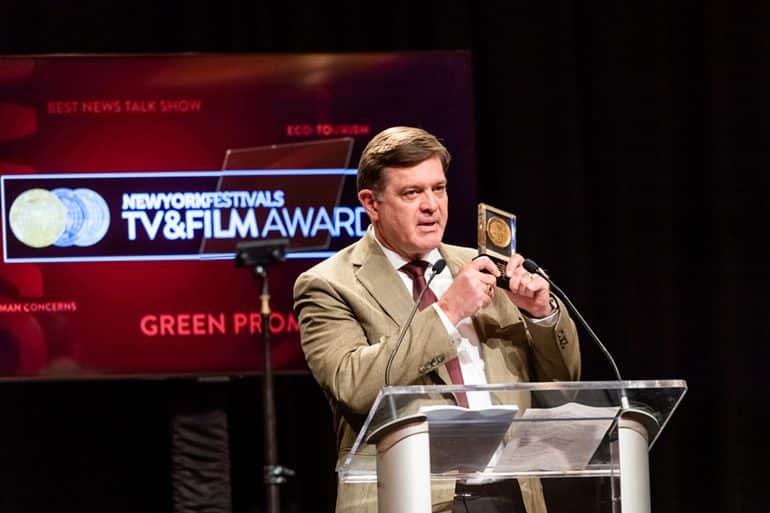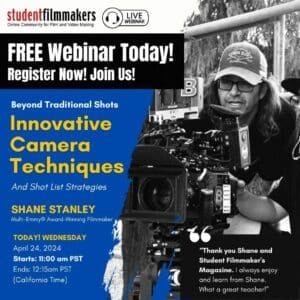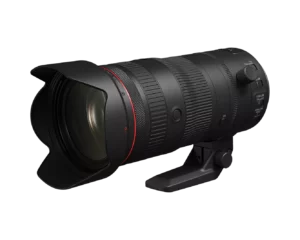Above photo of AJ Janitschek at the New York Festivals TV Film and Awards at NAB Show 2019.
Photo by Marc Bryant-Brown.
Filmmakers Global Network ::
Community Spotlight with AJ Janitschek
Director of Operations and Production Support at Radio Free Asia.
Current Projects:
We’re still quite busy at Radio Free Asia producing our daily radio and TV programs for broadcast, satellite and social media. You can find us online at RFA.org.
Adobe CC is the platform of choice at work but at home, I use Adobe Premiere Elements 14 for all my personal productions. It still gives me a lot of the functions I need to produce my own personal videos.
At work, my most recent production was a training video on the importance of different internal passwords, how often they expire and other related info. In our technical department, we get a lot of requests for help resetting passwords.
At home, I’m working on some short, Zen-type videos for YouTube. The idea is for the viewer to get a 90-second mental break by viewing a static shot of trees, water, mountains, or something else like that, all with natural sounds too. I’ve got three all ready to produce but you know how it goes; there’s never enough time to do everything you want to do. So, I’m just trying to find the time to pull them all together. I suspect most of us are always trying to balance our time between productions and the rest of the things we have going on. That also means taking time to bone up on our craft. I’ve been a member of Student Filmmakers for years because I know I still have a lot more to learn about film and video production. If Ron Howard or Spike Lee were here, and they really know their stuff, I think they’d echo this sentiment too. My education in filmmaking never ends and will continue until I’m gone.
Memorable Projects:
The one that comes to mind is from my time with the Armed Forces Network (AFN) in Germany.
I was new to video production and we had to produce a short, 30-second commercial, or actually a public service announcement, for AFN TV about an Army cook. The idea was that this cook not only did their job, but did it well, and that they really cared about what they did. The tag line in the theme song was “he’s U-S Army Europe and you know he gives a damn.”
My boss and mentor at the time, Herb Glover, was the senior producer and said that one of the shots he needed was a reverse cutaway of the cook placing loaves of bread into a large rack. I was on the ground, behind the rack and using a ‘beast’ of a camera and pointed it up and at an angle to get a number of different shots. The reverse angle was such a simple idea, but remember, I was new to filmmaking, so I would have never thought to shoot it this way.
It still sticks with me today that my limited view of filmmaking grew a lot with that production. I think it boosted my creativity and it showed in subsequent productions. Like in one other production that came shortly after; we needed to create a message about battery safety for cars. I was able to get a hold of an old battery that was cut in half, and after shooting over 100 stills of it in slightly different positions, the battery appeared to split open in front of the viewer’s eyes. I shot a lot of stills that day for just two to three seconds of motion. It wasn’t as sexy, but it was the subject we were asked to produce, and in this case, I was able to add some of my own creativity.
There are other projects, but this one sticks out in my mind.
Challenge and Solution:
An easy way to minimize your stress is to use a checklist of what to bring to every production, but some things are out of your control.
I volunteered to supplement RFA’s technical staff in Yangon, Myanmar for coverage of the 2015 national elections. One of my duties was to operate our satellite phone during live events.
Yangon is a lot like other cities, but it had a really relaxed vibe; the people were very warm and friendly. And everyone’s English was definitely better than my Burmese. The temperatures were about 90 degrees every day so there was no need to wearing business clothing either; comfort was the goal so we all wore very light clothing. It’s times like that when I thank Willis Carrier for inventing air conditioning; he’s right up there with the inventors of ice cream.
The opposition party, the National League for Democracy, was holding their largest rally on November 1, with the main speaker being Nobel laureate, Aung San Suu Kyi. We had a pretty good idea the cell networks would be saturated but that sat phone would give us quality audio and video we would need; we were going to have a great broadcast!
The day came and there were tens-of-thousands of supporters and spectators at the venue. It didn’t take long for us to realize Murphy’s Law would drive much of what we could accomplish. We also called it the ‘Rule of Z’ meaning ‘zero’ or ‘zilch.’ Let me tell you what happened.
Put a huge number of people in a limited area with an equal amount of cell phones. Guess what? It brought all cell networks to a screeching halt. Every smartphone where we had successfully streamed video just before the rally, suddenly stopped as the rally began. We couldn’t stream any more, emails stopped and even phone calls were suddenly limited. So, Murphy’s Law, or the ‘rule of Z’ meant no cell service and no video stream from the rally.
With time to spare before Aung San Suu Kyi spoke, we grabbed our satellite phone from our office and took a taxi to the site. We still had to walk the last half-mile in the heat carrying everything because the crowds were so heavy.
By the time I arrived, the press area of the stage was packed! There was no space left to set up the sat phone or even the tripod we brought to hold it in-place. The senior producer then made the right decision to set up operations further back from the crowd the camera crews could move through the crowds with greater ease. Once at the new locations, and having a make-shift table from a piece of plywood, we were able to set up our laptops and the satellite phone too.
With the cell networks down and a lot of reports of others having zero success with satellite phones, we were happy to see our sat phone connected successfully. It was here our senior producer made a smart move to save the day. With all our cell phones unable to stream video, the decision was made to use our sat phone Internet connection to post short videos, photos, and text ‘nearly live’ on Facebook until the rally was over. It was an impressive site! Our camera crews hustled for shots throughout the crowd and as soon as they returned, they gave us their SD cards with the footage which they swapped for a blank SD card. Once they had that, they disappeared into the crowd once again. This continued for the next couple of hours until the end of the rally. It was un-choreographed perfection.
Remember I mentioned having a production checklist earlier? None of us thought to bring water to the site. Just before the rally began, people were walking through the crowds handing out water. We didn’t realize that once things started, there were no more deliveries of water; you were on your own. Yep, you guessed it; as the hours when by we were hot and thirsty. The high humidity didn’t help us either. We needed water but the crowd was so dense, we couldn’t go buy any or even get it delivered. We just had to gut it out.
Long after the crowds left, we continued to push update-after-update to Facebook. People were long gone and most of the stage was already broken down by the time we finally. As you can guess, we were really thirsty and hungry too, but we were pumped up having just pulled off coverage of this huge event in Myanmar.
You know, I still think about the significance of Myanmar’s 2015 elections and the positive message it sent the world, but more importantly, I remember the names and faces of our friends and coworkers who still work in Yangon every day. Through my stay there was short, they showed nothing but kindness and friendship all the time. And I still chuckle about how I learned to make sure I always have enough water for any event.
3 Drone Tips:
Oh, that’s easy.
First, practice flying your drone for at least an hour a week. I’ve trained about 2-dozen people at RFA on flying our Phantom 4. Flying skills slipped noticeably when one of my students had to miss flying for a few days. I get rusty too when I skip it for a few weeks; it just rattles my confidence. It can really shake you when you are less than 100% confident and then you push the sticks in the wrong direction and bump into something. The more you practice, the less likely you’ll crash, but if you crash, get back to flying right away. You know what they say about falling off a horse, right? Hey, was that my second tip already? Nah.
Here’s my real second tip: when you practice be sure to have a set of maneuvers you always fly so you’re ready for any flying job. When I practice with any drone, I do fly overs, circles, figure 8’s, and also fly vertically trying to keep the camera on a single point of interest. Whether you get called to fly for a news event, search and rescue, or even a real estate gig, practice flying your drone like every camera shot is your money shot.
My last tip is just common sense stuff: stay Part 107 certified and stay up to day on drones, drones in the news, and on the latest drone legislation.



